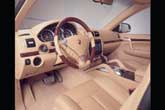Recent Articles
Popular Makes
Body Types
2006 Porsche Cayenne Turbo S First Drive
Porn for Horsepower Lovers
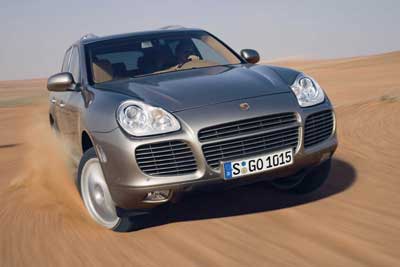
DUBAI CITY – We were well out of downtown Dubai on a six-lane highway that cut through the desert like a seam in an endless carpet when I starting thinking about killing camels. Not that I dislike camels, but I was wondering what would happen if we hit one while traveling 168 miles per hour in a nearly 6,000-pound truck. I tried to imagine the carnage, but I was distracted by the fact that the driver of the 2006 Porsche Cayenne Turbo S was no longer holding the steering wheel. “See, it’s stable,” said Jürgen Kern, Porsche manager of testing and quality management. “Even at this speed.” I glanced at the speedometer – 168 mph – and nodded appreciatively, but inside I was screaming: “Put your hands back on the wheel, Jürgen! Your freakin’ hands! Back! Wheel!” I knew Kern would push the new Porsche Cayenne Turbo S to its maximum speed, and that’s why I offered to let him drive. But I didn’t expect him to go all “Look, Ma” on me. Truly, though, the 520-horsepower SUV barely wavered at three times the speed of sanity. There was a little vibration, but nothing more than you’d get on slightly rough pavement, and none of the lightness and lift that usually comes with high speed. No wonder, though, because the 2006 Porsche Cayenne Turbo S weighs 5,875 pounds fully loaded with options. That’s 2,200 lbs. more than a 911 Carrera S. You’d need a jet engine to raise the wheels of the Cayenne Turbo S off the pavement. Regardless of the new Cayenne’s stability, we had just passed a “Watch for Camels” sign, which had inspired my morbid musings, and I wanted Kern’s hands back on the steering wheel. Our exit approached and he slowed to about a buck ten and made a lane change. Kern and I were now on a two-lane highway, driving past a meticulously-maintained Arabian thoroughbred ranch and several circular, rag-tag goat farms that dotted the desert like driftwood construction on a deserted beach. At the gates of the 50,000-acre Dubai Desert Conservation Reserve a uniformed guard waved us through. We stopped the Cayenne to reduce the pressure in the tires from 42 to 18 psi, and it was then that I saw my first camel, no doubt attracted by the hissing air or whatever piques the interest of the extremely simpleminded. Supported on massive, flat feet, it moved over a dune as though controlled by puppet strings – all gangly and disjointed. Up close, it was easy to appreciate the extreme hazard such an animal posed to vehicular traffic, not least because it blended into the sandy landscape. The desert was much different than downtown Dubai. Out in the vast, shifting dunes, you could imagine the Arabia of old, or least something more authentic than what looks like a Scottsdale strip mall. Dubai is the capital of the emirate of the same name (one of the seven United Arab Emirates). A city of 900,000, it sits on the shore of the Arabian Gulf. The tourism mecca of the UAE and the Middle East and one of the fastest-growing cities in the world, Dubai’s skyline bristles with cranes. Buildings under construction seem to vastly outnumber completed projects. Nothing, save for a small part of downtown Dubai, looks more than five years old. Western culture has fully infiltrated and obscured any Arab flavor. Think Phoenix with Arabic script. Starbucks, Applebee’s and other fast-food outlets line the main roads. There are shopping malls everywhere, including one attached to an artificial indoor ski resort chilled to 20 degrees Fahrenheit. Strolling through a mall made up like a traditional Arabian , or market, I was met by the unmistakable smell of a Cinnabon counter. I even spotted a huge Martha Stewart billboard in the city. We spent 90 minutes plowing over the dunes in the 2006 Porsche Cayenne Turbo S. Dubai’s sand is fine like talc and it feels much like driving on powdered snow over packed ice. Because the desert winds constantly change the landscape, Kern was never sure what lay on the other side of a dune. It was a trick to speed up the face and then reduce power at the crest to drop safely down the other side. Not enough power and you slid backwards, too much and you risked planting the nose of the $111,600 Cayenne in the sand, possibly busting up the grillework and maybe even the radiator. If there’s one thing I know about the desert, it’s that when you’re in the middle of it you don’t want to be leaking water. Just the fact that my concern was dependent upon driver error and not vehicle malfunction speaks volumes about how solid this Porsche is. Also consider that the 2006 Cayenne Turbo S can spank a BMW M3 coupe on the road. Sure, $111,600 amounts to plenty of sport-ute, but this isn’t just any SUV. The Porsche Cayenne Turbo S marries opulent luxury with on-road performance and off-road prowess. It’s like those freaks that excel in multiple professional sports, or a bigamist with three gorgeous talented wives. Now, that’s not something you see every day, is it?
Model Mix
Model Mix The 2006 Porsche Cayenne Turbo S model’s customer order guide is more confusing than the U.S. tax code and, at 33 pages, is a substantial document. It would take the IBM “Blue Gene” supercomputer to figure out which packages conflict with which individual options. Sales of the Porsche Cayenne slid in 2005, but nothing brings people back to the dealership like new blood, especially if that new blood is a genetic speed freak from the Stuttgart design lab. Of course, not everybody is going to slap $111,600 down for the top-of-the-line Turbo S, but the showroom traffic it generates is invaluable. In terms of safety equipment, the 2006 Porsche Cayenne Turbo S features six airbags: two front airbags and two thorax airbags for the driver and passenger, and two side-curtain airbags that stretch along both sides of the roof trim panel. This marks the first time Porsche has installed side-curtain airbags on any vehicle. They’re designed to inflate downward to protect passengers in the front and rear in the event of a side impact or rollover. In addition to the convenience features you’d expect at this price point, the 2006 Porsche Cayenne Turbo S comes with a full complement of luxury appointments, including bi-xenon headlights, a DVD-based navigation system, a Bose 14-speaker surround-sound audio system, and 12-way adjustable, heated seats with memory. Your significant investment also gets you an air suspension with Porsche Active Suspension Management (PASM), which automatically adjusts the suspension dampers depending on road conditions and driving style. There’s no charge for the 20-inch wheels or metallic paint, including the Turbo S-exclusive Marine Blue Metallic. Strangely, the base model does not include front and rear floor mats ($130). We would speak sternly to your salesperson about getting these “thrown in.” The 2006 Porsche Cayenne Turbo S model’s customer order guide is more confusing than the U.S. tax code and, at 33 pages, is a substantial document. It would take the IBM “Blue Gene” supercomputer to figure out which packages conflict with which individual options: Do you need to add the leather trim option for the defroster and mirror attachment ($1,480) if you have already checked off the interior leather package ($2,390)? Yes, you do. In fact, while you’re at it you might want to consider the leather covered seat bases ($2,430) and the leather-wrapped steering wheel column ($830). Plus, why not cover all the interior air vents in cowhide too ($2,160)? By our calculations, you can add in excess of $60,000 worth of options to the already astronomical base price. It seems a tad excessive. There are a few options we can see merit in, including the rear-view camera with park assist ($1,680), four-zone climate control ($1,690), and the panoramic moonroof ($3,900). Other options are intriguing, such as a system that preheats or ventilates the cabin according to your timer settings ($1,570) and the Guards Red instrument dials ($1,200) would be cool if not preposterously expensive. What’s that, 25 cents worth of red paint? It is a pain turning an ignition key so we might spring for the keyless entry and ignition system, called Porsche Entry and Drive ($995). The Off-road Technical Package with hydraulically disconnecting front and rear stabilizer bars, electronically controlled rear axle locking differential, rocker panel and skid plate protection, headlamp washer system, second tow lug, and additional protection for the fuel tank and rear axle ($4,290) sounds awesome, but we really can’t see taking this vehicle into any serious off-roading situations. Other options leave us cold. The cost of satellite radio exceeds the industry norm ($995) and putting the Cayenne logo on the center armrest is like paying to carry a sandwich board for a deli you like ($415). But, hey, it’s only money.
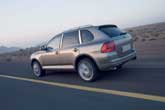
Nuts and Bolts
Nuts and Bolts “It surprised even us,” said Porsche engineer Jürgen Kern about the jump in power. “The turbo is already powerful enough, but this…” His voice trailed off as he pushed the accelerator and thrust my back flat against the seat. The only visual clue that differentiates the Turbo S from the regular Turbo is the silver “S” on the rear liftgate. Mechanically, there are also few differences between the 4.5-liter V8 in the Porsche Cayenne Turbo and same engine in the Turbo S – just a few tweaks to the turbocharging system – but those differences are significant. Horsepower jumps from 450 to 520 ponies at 5,500 rpm, and torque surges 73 pound-feet to 530 lb.-ft. at 2,750 rpm. The changes are good enough to affect a 0.4 second improvement in the 0-60 acceleration time to 4.8 seconds and to achieve a 3 mph top speed increase to 168 mph. Of course these improvements come with a price tag. The 2006 Porsche Cayenne Turbo S carries a $21,400 premium over its S-deprived sibling. It’s barely relevant to consider if the relatively modest gains in performance over an already phenomenal vehicle are worth the equivalent of the price of a Mazda MX-5 Miata. Are solid gold taps better than chrome-plated cast iron? Does a $3,500 Rolex keep better time than a $40 Timex? Of course not, but prestige has its price – the very best costs the very most. And Porsche engineers are among the best in the world. Owning something that represents the pinnacle of their achievement (so far) is certainly desirable. The power gains were realized by modifying the two intercoolers situated between the turbochargers and the throttle. The air heat exchangers were enlarged to provide more surface area and, thus, greatly reduce the temperature of the air being forced into the engine, which increases the efficiency of the system. In addition, the plastics used in the old intercoolers were replaced with aluminum structures, which optimize flow in and out of the heat exchanger, reducing the pressure losses that plagued the old system by more than 50 percent. These improvements increase the system’s boost pressure by 4.3 psi to a maximum of 27.5 psi, resulting in a corresponding increase in engine power. For example, the standard Cayenne Turbo reaches its peak torque of 457 lb.-ft. at 2,250 rpm, but the Turbo S produces 479 lb.-ft. at just 2,000 rpm. The Turbo S hits its peak 531 lb.-ft. at 2,750 rpm and maintains that thrust until 3,750 rpm. Not only does it produce more total power, but it produces more power too. In street vernacular, that results in hauling ass more than any other SUV-driving mofo on the road. “It surprised even us,” said Porsche engineer Jürgen Kern about the jump in power. “The turbo is already powerful enough, but this…” His voice trailed off as he pushed the accelerator and thrust my back flat against the seat. The joy of the 2006 Porsche Cayenne Turbo S is that it’s not all about straight-line power. Its handling characteristics are freakishly reminiscent of its 911 Carrera sibling. Porsche didn’t want to mess with that, so to accommodate the new power increases of the Turbo S, it also modified the front suspension. The track control arms are mounted on massive rubber blocks to absorb extreme lateral forces, whereas they are dampened hydraulically on other Cayenne models. Furthermore, the standard self-leveling air suspension features six different ride heights specially calibrated to provide optimum aerodynamics and safety at extreme speeds. When the Turbo S hits 78 mph, the ride height is automatically lowered 1.06 inches and at 130 mph it drops another 0.43 inch – another reason it feels stable at its speed threshold. Additionally, Porsche beefed up the braking system. The front brake discs were enlarged from 13.78 inches on the Turbo to 14.96 on the Turbo S, and thickness is increased to 1.5 inches from 1.34. The rear discs are also enlarged, from 12.99 inches to 14.09. The aluminum monobloc calipers are also bigger for maximum force and durability. New cooling ducts are designed to pump air through the brake discs for a 10 percent increase in cooling capacity, which means less brake fade and better performance. There’s also a commensurate jump in feel and confidence – when something feels as sure as the brakes in a Cayenne Turbo S, you drive better too. Adding to the feeling of stability and security is the standard Porsche Traction Management (PSM) system. Along with permanent all-wheel drive, it helps to ensure the Turbo S rarely stumbles on its way to terrifying your passengers. Under most driving conditions, 62 percent of the power is delivered to the rear wheels and 38 percent to the fronts, but should PSM detect slippage, it uses sensors to measure speed, lateral acceleration, steering angle and how far down you have the gas pedal jammed to make appropriate adjustments. It’s capable of transferring up to 100 percent of engine’s power to either the front or rear axle for maximum traction. It’s this lightning-quick adaptability that makes the 2006 Cayenne Turbo S so stable – even during extreme driving conditions.
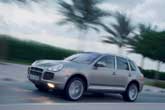
Driving Impressions
Driving Impressions Already doing about 80, I flicked the gear lever over to manual and then kicked down to third gear. The roar of approval from the four-pipe exhaust was thrilling but nothing compared to the surge in power when I pushed the accelerator and upshifted via the paddles on the steering wheel. At one point during our off-road experience in the Dubai Desert Conservation Reserve, Porsche engineer Jürgen Kern dropped me on a dune and I watched his technique. Roostertails of red sand plumed 15 feet from the wheels as he raced off behind a dune, reappearing moments later at the top. He dropped slowly down the face and the Cayenne plowed softly into the surface. As Kern gathered speed, sand poured from the grille like water from a sea creature emerging from the deep. The 2006 Porsche Cayenne Turbo S was totally in its element and, with an experienced driver behind the wheel, totally in command of the desert. It was amazing to consider that this was the same vehicle that, minutes before, was comfortably blazing along the blacktop at 168 mph. The surface of the desert is not consistent – some places are soft and others firm. The trick is discerning between the two because if you slow or stop in soft sand you are sure to get stuck. Then you either have to be towed out or endlessly twist the steering wheel while in reverse and maintaining 2,000 rpm. It might take you 10 tedious minutes to crab-walk 20 yards to firm sand. Do this once and you will never get stuck again. Of course, the desert conspires against you and you do get stuck again despite your best intentions. We used the sides of long, sweeping dunes like the raised embankments on a race track, traversing long distances and then dropping down in a cloud of sand or cresting like a surfer cutting back against a wave. It was exhilarating to play in such a capable vehicle. Back on the road with the tires refilled to 42 psi and Mr. Kern no longer aboard, I drove the Cayenne Turbo S back to downtown Dubai. On the return trip, I pushed the Cayenne to near its maximum speed only briefly, because I had no confidence in my ability to talk my way out of an Arabian jail. (I lack the of Mr. Kern, who looked ready for anything in his cool shades, safari vest and desert boots.) Mostly, I cruised at around 100 mph and was regularly passed by Mercedes-Benz S600s, their drivers chatting into cell phones and dressed in white robes and white held on by black coils. I wondered if one or two of these were sheikhs from the Dubai ruling royal family, but maybe an S-Class is too down-market for those dudes. Later, a red mid-1990s Ford Mustang GT sped up the left lane. Paint flaked off the old pony car’s corners where it was chipped and dented. As it got closer, I could see a white number 4 painted on the door. It pulled level and the passenger looked at me and the Turbo S and then the Mustang pulled away. Aftermarket louvers shaded the rear window. It was too much. Already doing about 80, I flicked the Cayenne’s Tiptronic gear lever over to manual and then kicked down to third gear. The roar of approval from the four-pipe exhaust was thrilling but nothing compared to the surge in power when I pushed the accelerator and upshifted via the paddles on the steering wheel. In a moment, I was traveling 130 mph and the flakey Mustang was a dot in my rearview mirror. It happened as fast as it takes to read that last sentence, but the tingling of unleashed adrenaline remained for a long time afterwards. It was a dramatic moment for me, but the 2006 Porsche Cayenne Turbo S seemed not to notice – just another moment in the life of an incredible piece of machinery.
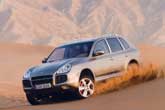
FAQs and Specs
FAQs and Specs The 2006 Porsche Cayenne Turbo S competes against the BMW X5 4.8is, Chevrolet TrailBlazer SS, Infiniti FX45, Jeep Grand Cherokee SRT-8, Land Rover Range Rover Sport Supercharged, Mercedes-Benz ML63 AMG When can I get a 2006 Porsche Cayenne Turbo S? The 2006 Porsche Cayenne Turbo S went on sale this past January. How does the power of the 2006 Porsche Cayenne Turbo S compare to other Porsches? The 2006 Porsche Cayenne Turbo S is the second most powerful road vehicle ever built by Porsche. The 600-horsepower Carrera GT ranks as number one. How is the 2006 Porsche Cayenne Turbo S worth $20,000 more than the regular Turbo? How is one Van Gogh oil painting is worth millions more than another? Bad example – paintings don’t do 0-60 in 4.8 seconds. When you consider that you can spend more than $60,000 on mostly aesthetic options for the Cayenne Turbo S, twenty grand seems pretty reasonable for 72 more horsepower and the baddest ride on any block. SPECIFICATIONS Test Vehicle: 2006 Porsche Cayenne Turbo S Estimated Price Range: $111,600 to $170,000 plus (not including $815 destination charge) Engine Size and Type: 4.5-liter V8 Engine Horsepower: 520 at 5,500 rpm Engine Torque: 530 lb.-ft. between 2,750 and 3,750 rpm Transmission: Six-speed automatic with Tiptronic manual shift feature Curb weight, lbs.: 5,192 EPA Fuel Economy (city/highway): 13/18 mpg Length: 188.3 inches Width: 75.9 inches Wheelbase: 112.4 inches Height: 66.9 inches Max. Seating Capacity: Five Max. Cargo Volume: 62.5 cubic feet Max. Towing Capacity: 7,716 pounds Competitors: BMW X5 4.8is, Chevrolet TrailBlazer SS, Infiniti FX45, Jeep Grand Cherokee SRT-8, Land Rover Range Rover Sport Supercharged, Mercedes-Benz ML63 AMG
Photos courtesy of Porsche cars North America
